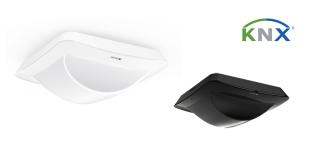How KNX Secure protects smart buildings – and what planners, installers and operators should keep in mind.
In intelligent building technology, smooth and secure data flows are essential. This is particularly important in KNX installations for residential properties and commercial buildings. The KNX IP interface from JUNG is the central link between the KNX system and the IP network – for commissioning via ETS, visualisation with the Smart Visu Server, and potential remote maintenance via the internet. In these cases, the interface enables communication between the KNX bus and various IP-based devices.
With eight tunnelling connections, the JUNG KNX IP interface Secure is well equipped for multi-user environments – such as when commissioning or diagnostics need to run in parallel with visualisation. Additional advantages include the compact DIN-rail housing, the bus-independent power supply, and full system compatibility with all JUNG KNX components.

Implementing KNX Secure with JUNG
The demand for secure implementation of intelligent building technology is growing in both residential and commercial settings. The reasons include an increasing number of cyberattacks, as well as legal requirements. The German implementation law for the NIS-2 Directive, designed to strengthen organisations against cyber threats, is expected to come into force in autumn 2025. Planners, contractors and operators can already prepare for these regulatory requirements by securing their KNX systems with KNX Secure.
KNX Secure is a protocol for encrypted communication – both on the bus line (Data Secure) and over the IP network (IP Secure). The JUNG IP interface has been designed for this purpose: it enables encrypted network access, for example when the Smart Visu Server app is used for visualisation.
Use case: single-family home
A typical application illustrates how this works in practice: in a single-family home, a KNX system with full visualisation was installed. All control functions, from kitchen lighting to shading, are handled via the Smart Visu Server, which communicates with the KNX bus via the JUNG IP interface. To secure the connection, encrypted communication was activated. The installer exported a project-specific Keyring from ETS and imported it into the Smart Visu Server. This ensured that all telegrams sent via the network could only be read by authorised systems.
To successfully implement KNX Data Secure, every KNX component along the communication path must support Secure functions and be correctly integrated – for example presence detectors, push-buttons or dimming actuators in the case of the kitchen lighting. Only if all devices support KNX Secure and are correctly configured in ETS will the communication be fully encrypted. Missing group addresses or incomplete configurations result in telegrams being ignored – a clear security advantage. The JUNG IP interface supports this process with practical key management and tunnelling features.
Preparing for KNX Secure with JUNG
All JUNG KNX Secure devices have a specific Factory Default Setup Key (FDSK). This unique device key can be imported into the ETS. Particularly helpful: with JUNG KNX components, this is done quickly and conveniently via a QR code on the device. After installation, the responsible party can keep the label for secure storage. In this way, a Secure communication can be prepared during the initial commissioning without having to replace devices later. This is not only future-proof, but also in compliance with the upcoming requirements of the NIS 2 Directive Implementation Act, which requires appropriately documented security measures.
Whether in commercial environments with high access levels and critical functions, or in private homes – the KNX IP interface from JUNG enables modern requirements for networking, stability and data security to be met in a future-proof way. It bridges the classic ETS world with today’s needs for visualisation, remote access and tamper protection – offering a scalable and secure platform for building automation.
More information visit:












